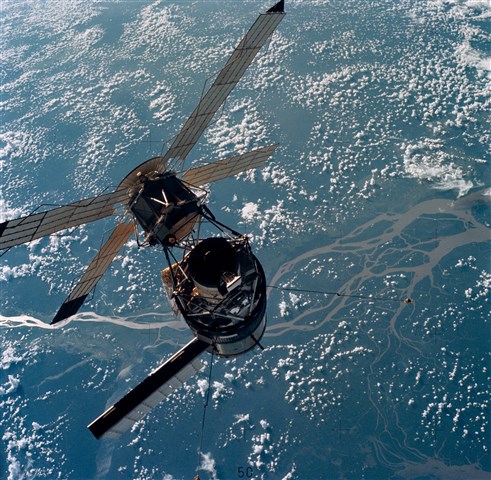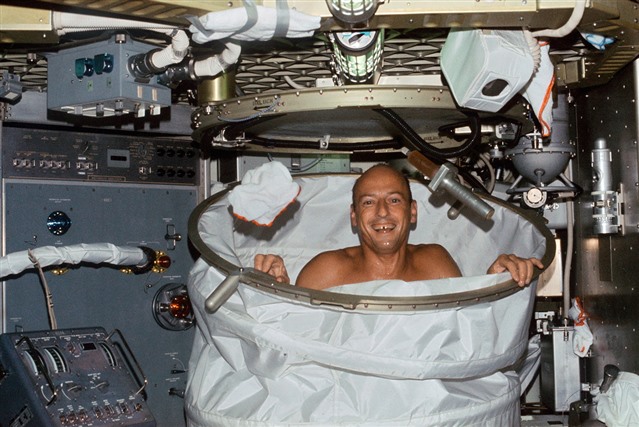Space is a dangerous environment and getting there is equally hazardous. Then there is human ingenuity to get around any problem…
May 14, 1973 - Skylab, the United States' first space station, is launched.
We have been here before. Cape Canaveral is about to see the launch of another Saturn V rocket, the massive ‘candle’ that took astronauts to the moon and back. But that program ended in December due to budget cuts. What else can NASA do with its spare Saturn Vs and the 400,000 strong workforce that made the Apollo missions possible?
Build and launch the first US space station, build and launch Skylab.

Skylab configuration as planned Source: Wikimedia Commons
In the 1950s, figures such as Arthur C. Clarke and Wernher Von Braun (by now technical director of the US Army’s ballistic missile program) believed a massive orbiting space station (not unlike the one featured in the film ‘2001: A Space Odyssey’) would be required as a staging post for further space exploration, such as a moon landing, and tasks like Earth photography and military surveillance. It would have required a fleet of 7,000 space shuttles to build it in space, with a crew of 80 to run the completed station.
The Space Age arrives…at last
Sputnik, and the satellites which came after, put an end to that vision because they could carry out most of the tasks the station would have undertaken. But the idea didn’t go away. Instead, it grew out of the Apollo Applications program - a scheme designed to repurpose Apollo program hardware for scientific study, which would eventually give birth to Skylab.
Wernher Von Braun - rocket engineer, father of Germany’s rocket programs during the Second World War and, at this stage in the story, leading NASA’s Marshall Flight Center – wanted to keep his staff employed following the recent end of the Apollo missions.
To this end, he supported the building and launch of an orbiting science lab that would use left over equipment and parts from the moonshots.
As it was, Skylab was built from the unused third stage (called the S-IVB) of a Saturn V rocket, converted for use with vertically fitted decks for living quarters and workspaces to carry out science experiments. Apollo command and service modules would bring in the crews and some supplies. With a mass of 75,000kg, Skylab was at this point the heaviest object ever carried into space.
Unplanned events
The launch of Skylab 1 (the actual space station) was set for May 14, 1973 from Pad 39A at Cape Canaveral. Skylab 2, the men who would crew the station for the next four weeks, would launch twenty-four hours later from Pad 39B.
When the day came, 25,000 spectators were there to watch the last Saturn V blast off. Its five F-1 engines burst into life at 12:30PM, Eastern Daylight Time. Assisted by 3.4 million kg of thrust, Skylab heaved itself into the sky, before slipping behind the cloud cover.
For 63 seconds of the flight, everything appeared normal. Then rocket telemetry pointed to the micrometeoroid shield failing. Shaken loose by vibration when the vehicle passed the sound barrier, it was ripped off in the slipstream. Next, one of the solar array wings deployed early, just before the second stage burn. When retro rockets fired to separate the booster stage from the main payload, the exhaust tore off the array.
Ten minutes after lift-off, Skylab was in Low Earth Orbit (LEO), but at what cost?
Owen Garriott performing an EVA in 1973, during Skylab 3. Source: Wikimedia Commons

Skylab, with its docking adapter visible. Photographed with a hand-held 70 mm Hasselblad camera using a 100 mm lens and SO-368 medium speed Ektachrome film. Source: Wikimedia Commons
An orbiting roasting tin
It was soon found that the second solar wing array was tangled in debris, and unable to open. Worse, the thermal shield had gone the way of the micrometeoroid shield. Not only was the station without half its power production capacity, it would rapidly cook in space.
The crew waiting for launch the following morning, would not be flying any time soon.
The good news was that the station successfully separated from the Saturn V and deployed the Apollo Telescope Mount. Attached to this were the three crucial Control Moment Gyroscopes (CMGs), which would stabilise the station. Also successfully deployed were the X-ray, visible-light, and ultraviolet solar physics instruments. Even better, the solar arrays (looking like an unfurled flower) mounted with on the Apollo Mount, fully unfurled and deployed.
The bad news was that with one solar array missing and the second unable to open fully, Skylab was operating on 25 watts of electricity, not the planned 12.4 kw.
Worse, loss of the heat shield now meant temperatures, an exterior surface temperature of 179°C and 38°C in the habitable interior, were rising and expected to double. In turn, extreme temperatures risked the outgassing of materials on internal walls, an event that would destroy food and photographic film. It would also poison the station’s atmosphere with toluene and carbon monoxide gasses.
Remarkable feat

Charles "Pete" Conrad, Commander of Skylab 2, smiles after using the zero-gravity shower. Source: Wikimedia Commons
The crew (Commander, Charles “Pete” Conrad, Pilot, Paul J. Weitz, and Science Pilot, Joseph P. Kerwin) eventually made it to Skylab, on May 25. On their second day in orbit, they had to ‘step’ outside to place a 6.7m x 7.3m woven nylon, mylar and aluminium sunshade on the station exterior. A spacewalk on June 7, allowed them to untangle the remaining array.
In all, the men of Skylab 2 spent 28 days in Earth orbit, setting a new record for the number of days in space.
Skylab itself hosted two more three-man crews, Skylabs 3 and 4. Its 172 total days of habitation easily exceeded the 140 days it was designed for. During that last mission, one of the stabilising gyroscopes failed, and the second began showing signs of imminent failure.
And in the end…
The station itself was on a low, and deteriorating, orbit, which eventually saw it return to Earth, breaking up over the eastern Indian Ocean and Western Australia on July 11, 1979. In response, the Australian Shire of Esperance fined NASA A$400 for littering, which was eventually paid off in 2009.
An overhead view of Skylab in Earth orbit as photographed from the Skylab 4 Command and Service Modules (CSM) during the final fly-around before returning home. Note the missing solar wing array and the gold ‘parasol,’ designed to protect the station from overheating by solar heating. Source: Wikimedia Commons
Is space exploration worth the money that’s spent on it?
Is unmanned space exploration a better bet, being cheaper and less dangerous to any people that would otherwise be carrying it out? Leave your thoughts in the comments!
 By Stephen Phillips - IET Content Producer, with passions for history, engineering, tech and the sciences.
By Stephen Phillips - IET Content Producer, with passions for history, engineering, tech and the sciences.